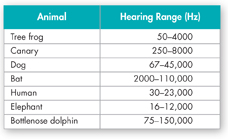Chordate Sense Organs Nonvertebrate chordates have few specialized sense organs. In tunicates, sensory cells in and on the siphons and other internal surfaces help control the amount of water passing through the pharynx. Lancelets have a cerebral ganglion with a pair of eyespots that detect light.
In contrast, most vertebrates have highly evolved sense organs. Many vertebrates have very sensitive organs of taste, smell, and hearing. Some sharks, for example, can sense 1 drop of blood in 100 liters of water! And although all mammalian ears have the same basic parts, they differ in their ability to detect sound, as you can see in Figure 28–7. In fact, bats and dolphins can even find objects in their environment using echoes of their own high-frequency sounds. A great many species of fishes, amphibians, reptiles, birds, and mammals have color vision that is as good as, or better than, that of humans.
Some species, including certain fishes and the duckbill platypus, can detect weak electric currents in water. Some animals, such as sharks, use this “electric sense” to navigate by detecting electric currents in seawater that are caused by Earth's magnetic field. Other “electric fishes” can create their own electric currents. These fishes use electric pulses to communicate with one another, in much the same way that other animals communicate using sound. Many species that can detect electric currents use the ability to track down prey in dark, murky water. Some birds can detect Earth's magnetic field directly, and they use that ability to navigate during long-distance migrations.

FIGURE 28–7 Vertebrate Hearing Human senses are not necessarily superior to those of other animals. Interpret Tables Would you expect to be able to hear the highest pitch a dog can hear? Explain.
28.1 Assessment

-
Review List three body systems that work together to create a response to a stimulus.
Explain What is the role of a motor neuron?
Sequence What is the correct sequence of the roles played by the following in the response to a stimulus: interneuron, motor neuron, sensory neuron, muscle.
-
Review What are two general ways in which nervous systems differ among animal groups?
Compare and Contrast Describe the degree of cephalization shown by cnidarians, flatworms, octopi, and vertebrates.
-
Review Give an example of an animal with a very simple sensory system and an example of one with a complex sensory system.
Infer What is the general relationship between the complexity of an animal's nervous system and that of its sensory system?
WRITE ABOUT SCIENCE
The compound eyes of insects detect movement better than they distinguish details. How might the ability to detect movement be more important to an insect than the ability to see fine details? (Hint: Consider the size of an insect in relation to that of its predators.)

Table of Contents
- Formulas and Equations
- Applying Formulas and Equations
- Mean, Median, and Mode
- Estimation
- Using Measurements in Calculations
- Effects of Measurement Errors
- Accuracy
- Precision
- Comparing Accuracy and Precision
- Significant Figures
- Calculating With Significant Figures
- Scientific Notation
- Calculating With Scientific Notation
- Dimensional Analysis
- Applying Dimensional Analysis





